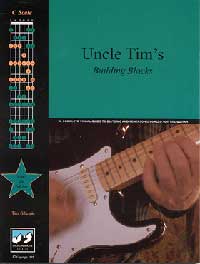

How Does Uncle Tim's Building Blocks Work?
Simply! Here is the concept behind every page of UTBB.
On the fretboard of the guitar is a pattern of notes, once you learn it, you have immediate access to every scale in every part of the fretboard, for every key.
And it is easy to learn the pattern if you look at a picture of it, and music theory is what creates this pattern. This approach makes it super easy! Super easy!
There is nothing like it and nothing can make up for it. For $20, you can put this all to rest right now. Pick up a copy today.
eBooks are delivered instantly!
By Tim Gillespie
This month there are no animated .gifs to view. Instead, we are going to concentrate on what has already been presented.
When I was teaching, I would often ask a student if he or she knew the scale under study. Most of the time the student would tell me they did know the scale. So I would test him. Not to prove anything or beat him up, but more to understand how well they really did know the scale and to show him how well you must know this stuff.
Sometimes the student would be able to pass several of the tests, but I could always bring the test to a point where he would start to either miss notes or fail all together.
This was intentional! The purpose was to illustrate how well you must know scales to get any benefit from them.
You must know the scale inside out as well as backwards to play it on demand. Most of the time when you learn a scale, you do so by starting on the tonic note and progressing through at least one octave. This is the most common way to practice a scale. Sometimes a student would be able to start on an arbitrary note and descend or ascend to the higher registers.
But often times when I would suggest starting on a note in the middle of the scale, things would begin to fall apart. Sometimes a student would have to start at the lowest note because it was the only way he could play it correctly. Very few times in an improvisation, will you start on the first note of the scale and then play every note in sequence. More often, you would start on some note and then mix up the order and omit certain notes (like the seventh note, for example).
You must know the scale from all sorts of arbitrary starting points. You must be able to jump an octave or more and pick up where you left off. You must be able to move up or down, left or right and often times jump to different parts of the fretboard to satisfy creative urges that may develop. In a real jam session, you may only have a second or two to get the phrase right.
So for this week, I suggest this. Let's tear apart the scale we have been working with in an effort to cause mistakes. Mistakes that will expose a weakness Mistakes that you will learn from.
Let's start with this. Play the scale starting with the first note (tonic), then skip to the 8th note (one octave higher). Then play the 2 note, then the 7 note. Then the 3 note, then the 6 note, then the 4 note and finally the 5 note. The progression would be 1, 8, 2, 7, 3, 6, 4, 5. Chances are you made a few mistakes, if you tried to play this. Your eyes are not oriented to seeing the scale like this. You may have had to stop and figure out what note comes next. If you always play 1, 2, 3, 4, 5, 6, 7, 8, you will probably have trouble mixing up the order. Try another one. How about playing 1, 4, 3, 8, 2, 5, 7, 6. How about 1, 16, 8, 2, 9, 3, 10, 4, 11, 5, 12, 6, 13, 7, 14, 8. Get the idea? By the way, the last example should stop all sorts of people from getting it right. A sequence like this is difficult for me for at least three or four attempts. If I take the time to struggle with it, I will understand the scale much better when I finish. If you try hard enough, you can cause anyone to stop and think before they play it right.
If this presents too many problems, then scale back and find the right level of complexity for you. The idea is to make yourself fail. Find the areas of weakness and examine them. Really get to know the scale. At first you may want to work within one octave and concentrate on just a few notes. Mix up the sequence in an effort to combine different intervals and create interesting combinations.
We are trying to force our mind to think "out of the box". We want to get to know this scale really well. Two months ago we introduced a four note burst that made you think about the sequence of notes in a riff. This is more of the same, only we are trying to come up with new ways that makes us think about the scale and the key.
This set of exercises can really improve your phrasing and passage creation. It will help you to think differently about the typical sequence of pathways and playing habits.
After you do this for a while, you may find it very gratifying to insert a triad or two, right in the middle of a run. Remember everything works together, if you can command it to!